

The first cassette tape owned by Alaska—the internationally celebrated drag queen, singer, songwriter, comedian, actor, podcaster, author, pageant judge (did I miss anything?)—was the single of Ace of Base’s “All That She Wants”. The Swedish duo’s fetching Eurodisco tune surfed the American airwaves in the mid-1990s and ultimately helped spur the tsunami of bubblegum pop that would soundtrack the turn of the millennium, from Britney to *NYSNC to TLC. But for Alaska Thunderfuck 5000 (named after both the state and the strain of sticky icky), it represents something closer to home.
“For children of my generation, I feel like we always remember our first cassette tape, our first CD. And so it was really special to me,” she tells PopMatters. For these reasons and more, it was “an easy decision to make” to cover the indefatigable track on her fourth LP, Red 4 Filth, a bustling and indisputable dance-pop record that filters Alaska’s beautifully weird worldview through the sheen of a 1990s and early 2000s house party.
“I know every word and I know every sound of that song,” she says of “All That She Wants”. “And I know every beat and nuance and harmony. We had talked about covering other songs, but there was really no contest. It had to be Ace.”
Like flared denim and pop-punk head-banging, resuscitations of the 1990s and aughts are all the rage right now, thanks to pandemic-aided burnout and a desire to return to the lattermost timeline in which the internet and Big Tech didn’t reign over us with an aluminum fist. But compared to the Olivia Rodrigos and Willows of the world, whose inklings to revisit the era may be more inspired by an effort to escape to a fabled realm that existed before they were born, Alaska’s enthrallment with the 1990s and early 2000s is not one of imagined nostalgia but lived experience.
“We wanted to do that sort of Y2K vibe [for the album],” she says, “where it captures the feeling and essence of a time period. And originally, we were like, let’s do the 1980s, and then it was the 1980s into the 1990s, and I thought we gotta bump that up because I was really obsessed with the sound and the feeling of the early 2000s and all the horrible clothes and weird cellphones, and the internet was so new. It was such a strange period in time that I’m just kind of fascinated by.
“And I also lived through it,” she emphasizes. “I was a teenager, and around that time is where I really fell in love with music. So it all just made sense for me to go there.”
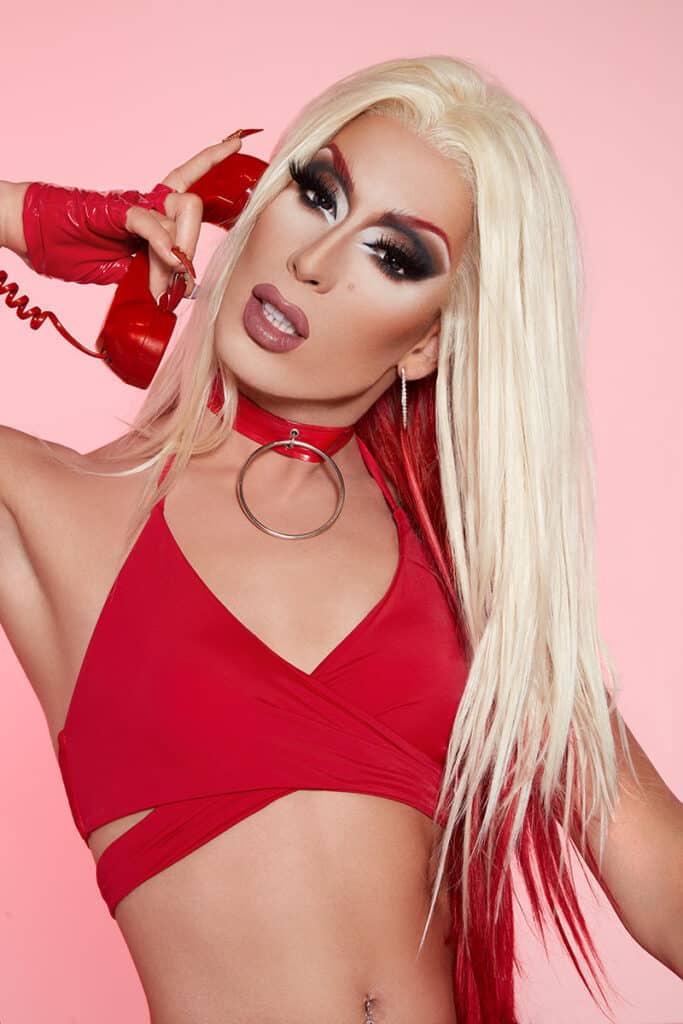
It’s nearing noon on a sunny SoCal morning as I chat with Alaska about the two projects currently steering her life: Red 4 Filth, both the album (which dropped earlier this year) and its upcoming tour, as well as Alaska’s brand-new musical production, DRAG: The Musical. I first ask her how she’s feeling about the Red 4 Filth tour, her first solo North American circuit.
“I’m shitting my pants each day,” she deadpans. “It’s really getting close to it, and I just want it to be really cool. I mean, the album is unlike anything I’ve ever done before, so I want this tour to be unlike anything I’ve done before. I’m ready to take people on a journey through time and space and tell a real story with this music being the soundtrack.”
The excitement and understandable anxiety come through in her body language as she avidly leans forward but rests her chin on a tightly wound fist. Because Alaska is out of drag, sitting at her desk in a plain black tank top, I suppose I’m technically speaking with Justin, the jaunty yet assiduous 37-year-old human being behind the extraterrestrial glamazon that is Alaska. But the distinction between the two is as threadbare as a knockoff synthetic wig.
“Alaska is not some sort of, you know, carefully crafted machination,” I’m told. “She’s actually just an extension of who I am, so everything is organic.” Alaska capitulates, “There’s definitely different voices that I have. I have my speaking voice, and then I have my whispering kind of drag alien voice, and then I have my rapping voice, and then I have my podcasting voice. I’ve always liked to do different things with my voice, so different songs call for a different sound.”
Alaska’s approach to her drag has always been kooky, clever, and raunchy in even measure, filled with enthusiasm for all things sexual liberation and DIY fashion. And yet, she’s also not afraid to use her acrylic nails to scratch at the flawed humanity behind even the most indefectible female impersonations. Her voice is indeed both distinct and malleable, and it’s used to great effect on each of her various creative pursuits. Her deep, droll speaking voice makes for acute comedic timing, and her nasally, gender-bending singing voice punctuates her effervescent music with a sly knowingness that sets her apart from Top 40-dominating pop stars and other drag performers alike.
However, hers is not the only voice that shines on Red 4 Filth. As happy as Alaska is to stand in the limelight on her own, collaborating with other queer artists is an equally important part of her M.O. For the R&B-infused empowerment hymn “I Am Her (She Is Me)”, Alaska called up trans activist/irrepressible television personality Ts Madison, whom she doesn’t hesitate to note has just worked with Beyoncé on Renaissance, making Alaska “just one degree away from” the Queen B herself.
“I originally just wanted Ts to come on and, like, do the hook and just sort of be the hook girl,” Alaska says, barely containing her elation. “And she showed up and she was like, ‘No, I wrote this verse.’ And it was incredible, and she just knocked it out of the park and made the song a thousand times better than I ever imagined. She’s like a modern-day prophet to me. She’s really, really inspiring and her energy is just brilliant and uplifting. I’m obsessed with her.”
She also recruited the NYC-based Stephanie’s Child, “the best drag girl group” she knows, for a feature on “Girlz Night“, a finger-snapping jam destined to become a slumber party staple for years to come.
“I knew that I wanted to capture that Spice Girls, S Club 7, ‘bang bang into the room’, Lady Marmalade kind of feeling, you know?” she says. “Where the girls all get together and be kind of hoochie coochie sluts a little bit. Stephanie’s Child—they’re all such brilliant singers and they’re friends of mine, so I pulled them out of retirement.”
Alaska’s affinity for the music that scored her youth is evident throughout the record. Stand-out track “wow” takes a palm-muted bass line and fat kick drum straight from All Time Low’s playbook, while “uh” plays with its Chicago house roots for an anti-internet club banger. In just 13 tracks, Alaska takes listeners on a time-warping nostalgia trip across a decade, a country, and a whole swath of pop sounds and influences.
The record’s biggest surprise, however, comes from “22”, a sneakily affecting track in which an older Alaska comforts her younger self, a budding artist with a hankering for drawing portraits of a fashionable girl whose silhouette appears eerily similar to that of modern-day Alaska. “Twenty-two’s around the corner / Hold on a little bit longer / Promise it’s gonna get better,” she intones over a sunny, stripped-back guitar with enough gravitas in her voice to keep the adages heartfelt but not saccharine.
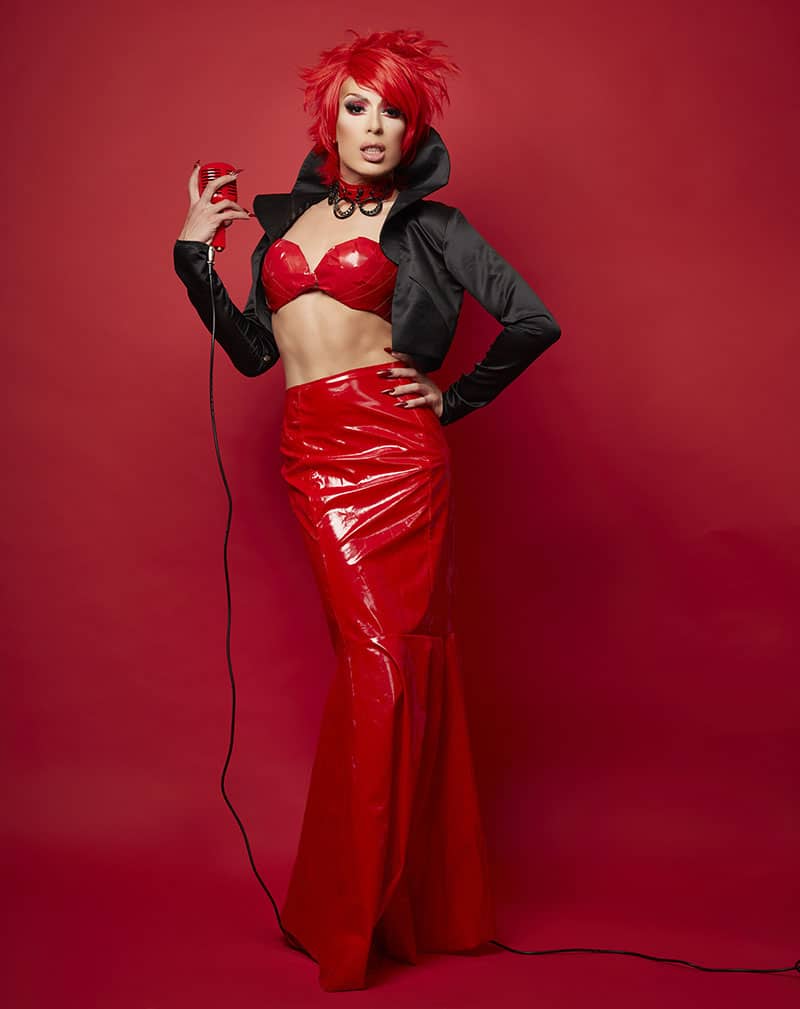
Mining material from one’s lonely, potentially traumatic childhood and adolescence is not exactly untapped water for queer artists. Yet for many in the LGBTQIA+ community, the period of self-entrapment and subsequent discovery of one’s place in the world through art, literature, and media, and, more recently, the world wide web, is a shared, arduous yet soul-affirming experience.
Alaska’s teenage years in Erie, Pennsylvania, were filled with both an obsession with the pop music of the times and a budding, newfound passion: theater. She performed in The Music Man, Joseph and the Amazing Technicolor Dreamcoat, and Oklahoma! all before attending university for a theater degree—and it wouldn’t be long after that she first adopted the persona of Alaska. When reminiscing on those experiences, she says, “That’s where I first felt like, oh wow, I’m kind of good at something—because I was horrible at every sport, you can imagine. And it was like, oh, musical theater, that’s it. I kind of make sense here.”
It is fitting that, later tonight, Alaska will be donning herself in full drag and taking the stage of the Bourbon Room in Hollywood, where she’ll be dancing and singing and performing her ass off in DRAG: The Musical. The live musical-comedy follows two rival drag clubs forced to work together after some financial troubles threaten to shut them both down. The show is stacked to the nines with an all-star cast of fellow Drag Race alumni like Jujubee, Jan Sport, and Jackie Cox, as well as Broadway and Hollywood stars Nick Laughlin, Joey McIntyre, Miah Blake, and plenty of other icons.
DRAG: The Musical was no overnight enterprise though. Six years in the making, the production was first conceptualized by Alaska’s longtime musical collaborators, Tomas Costanza and Ashley Gordon. And what was her response when broached with the idea of writing a musical together?
“‘Yeah, sure, why not?'” she attests, as casually as one would agree to split an appetizer. “And so we just, like, started chipping away at it and came up with a sort of skeleton of the story. We started with writing the songs and then started to figure out who these characters were, and then over that process, we really started to care about the characters, and they became part of us. Then six years later we finally put it up in front of people, and people really loved it and, like, lived.”
Those fortunate enough to have made it to a show at the Bourbon Room truly have lived, as reviews have proven unanimously positive for the production—and the queen at its center. Andrew Child of Broadway World deems Alaska “the undeniable and unequivocal star of the show”, adding that “every gag, every lyric, every cross of the stage is oozing with the star quality that makes DRAG a ticket worth every penny.”
Nevertheless, Alaska remains humble about her own musical theater prowess compared to her seasoned expertise as a drag performer. “I’m in awe of people who do musical theater because they can just sit there and hear this complex harmony one time, and then they can just do it. And I’m like, what? As a drag queen, I sing pretty much whatever I want, and if I have people singing with me, they sing around me and harmonize, and I don’t have to even think about it. So it’s been very expansive and definitely a challenge for me to step in and do what musical theater people do because it’s very, very impressive and very hard.”
The challenging work has all but paid off, and now that the production has come to fruition, I ask her if the final product is everything she imagined it would be.
“It’s more so,” she says, shaking her head incredulously, and she’s momentarily at a loss for words. “It’s like way more because when it’s on paper, and it’s in your own mind, you sort of have a vision of what it’ll look like and feel like. But once you have human beings who are so sickeningly talented stepping up and singing this music, it becomes something else—or in this case, it did. Because the cast of people we’ve got involved is, like, unreal, and everyone cares about their characters so much and really made it come alive.
“To see something that just started out as, like, I don’t know,” she adds, “fucking around with a guitar in a studio become this thing? It’s really, really cool.”
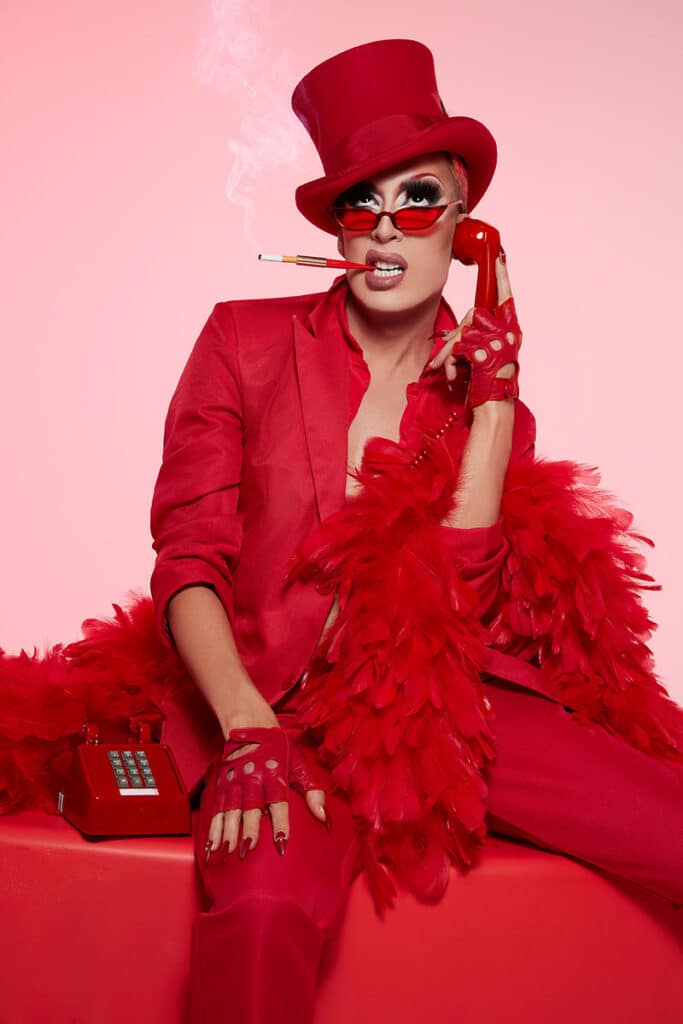
Like so many of today’s most illustrious drag queens, Alaska got her big break on a little-known reality competition series called RuPaul’s Drag Race. She emerged as a runner-up on the show’s fifth season and three years later sashayed her way back into the Werk Room for the second round of RuPaul’s Drag Race: All Stars, where she won the top honors and earned the coveted crown and scepter.
Alaska is thankful for her time on Drag Race and the legion of fans it exposed her to, though she recognizes that there are other species of drag out there that deserve the cultural spotlight as well. To build a platform for those artists, she co-created the Drag Queen of the Year Pageant Competition Award Contest Competition (yes, it’s a mouthful) in 2019 as an outlet for up-and-coming drag queens whose stylings don’t necessarily match the format of primetime reality TV.
“Drag Race is amazing,” she says. “It’s changed my life. It’s changed the world. But it kind of only showcases one type of drag. And so the more voices that are in the conversation and the more visibility that can be shared with every type of person on Drag Race or on the drag spectrum, I think the better off that we’re all going to be.”
Her last run on the show occurred six years ago, around the same time the seeds of DRAG: The Musical were being planted, in an era that seems to belong to a different cultural landscape altogether—before RuPaul was a multi-Emmy winner and the show’s contestants were securing Met Gala tickets and supporting roles in Disney films. Since then, the fandom surrounding Drag Race and its place in the zeitgeist has only grown more pronounced. Now the show not only dominates your local gay bar’s Friday night television screens but even your mother’s Facebook page could be littered with Miss Vanjie memes.
Getting swept up in drag has never been more accessible or, potentially, fraught with adversity. As Alaska and I’s meeting nears its end, our conversation drifts to the character of Brendan in DRAG: The Musical, a ten-year-old boy who gets engrossed in the world of feuding drag clubs and catty queens. The inspiration behind his character—played remarkably by Kayden Koshelev—didn’t come lightly, nor did it come from a place that wasn’t deeply personal.
“We really wanted the show to not just be a goofy, campy drag thing,” Alaska says. “We really wanted to get to the core and the heart. And for me, and I think a lot of people who do drag, there is that sort of child inside them who, you know, perhaps was told by society, ‘You’re not supposed to do that, you’re not supposed to play in girls’ clothes, you’re not supposed to play with Barbies.’ And that’s something that stays with you, kind of always, and so we wanted to put a character on stage that can have that experience and be at that pivotal moment in their life. That shit makes you cry, which is good. We want that.”
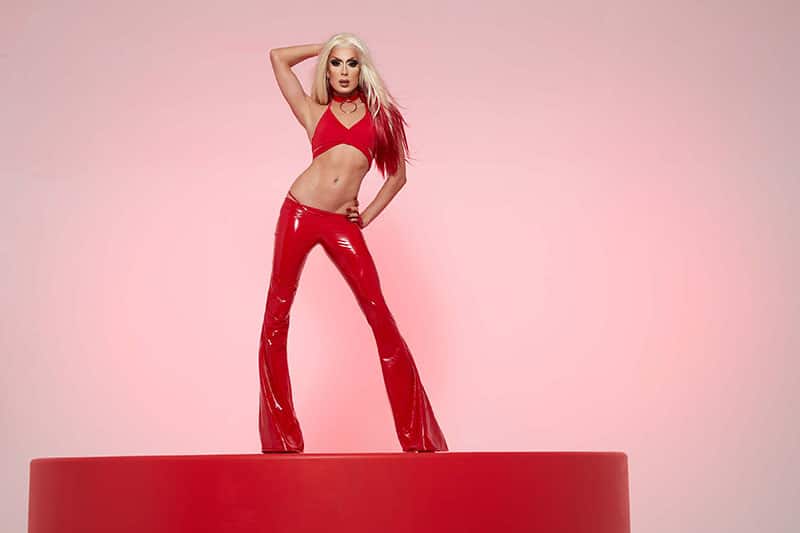
In light of the contemporary political moment and distressing reality for queer people across America, attention to this type of character takes on particular significance. Queer and especially trans and gender-nonconforming people are currently under siege in a cultural war fabricated by the political right in a cheap ploy to stir unrest and fear among their base. The art of drag—and in particular, its “appropriateness” for children—has landed at the center of the conversation, inciting hateful bigots to threaten and attack drag performers and the establishments that support them.
Like many of us, Alaska is in disbelief about the escalating situation, and she’s lately reflected on how the themes at the heart of DRAG: The Musical carry a whole new meaning in today’s climate. “When we started writing it however many years ago, we never could have predicted how much, like, ‘Drag Queen Story Hour’ and all these conversations that have come up in recent news…” Her voice trails off. “We never thought like, wow, this really is kind of touching on some shit that everyone is talking about right now.”
Predictable or not, it’s clear that Alaska’s and all other drag artists’ music, performances, and very presences are striking a chord. Like the child who sketched dresses in their bedroom with Ace of Base ringing in their ears all those years ago, and all the children like Brendan today feeling alienated and confused about whom they’re meant to be or love, young members of the LGBTQIA+ community need all the protection and encouragement they can get, and drag refuses to let their stories and rights go unheard.
I ask Alaska what she thinks members of the queer community can do to support the art of drag and counter this bigotry going forward. She doesn’t have one perfect answer, so her only advice is to keep doing what queer people have done for generations: persist.
“Just by doing drag and being out there and supporting your community, and that means supporting drag that goes beyond Drag Race,” she says. “There are people out there in every city every week, turning it and representing their community. So just being out there and doing it is activism and is raising awareness that this is a special fucking blessed art form. One that the world is really all the better for.”

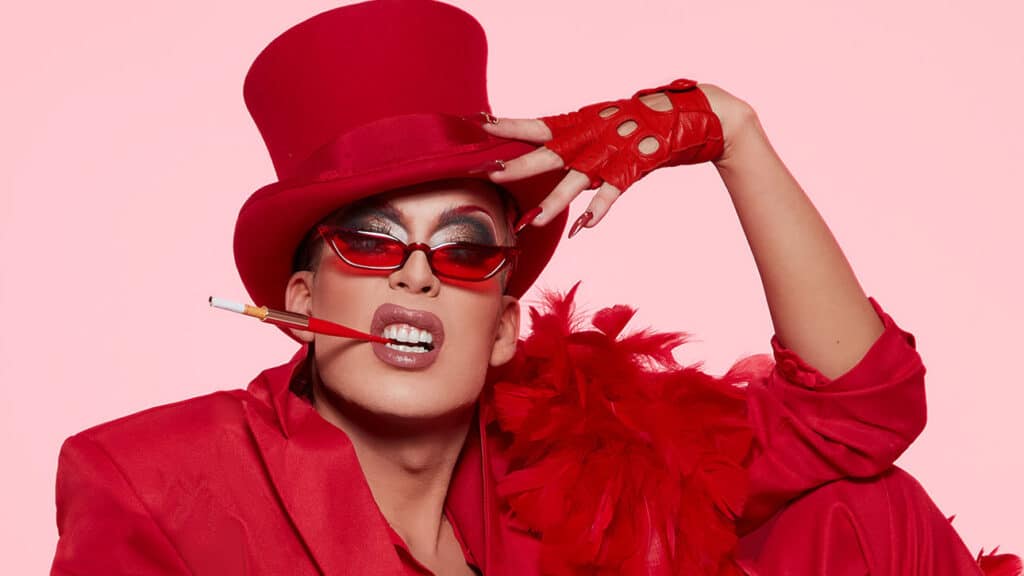
![Call for Papers: All Things Reconsidered [MUSIC] May-August 2024](https://www.popmatters.com/wp-content/uploads/2024/04/all-things-reconsidered-call-music-may-2024-720x380.jpg)



